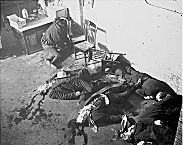| Entries |
| C |
|
Crime and Chicago's Image
|

|
By the end of the 1840s, observers both within the city and beyond regularly noted the existence of an identifiable criminal underworld. In the words of the Democrat, it was “getting to be a notorious fact that robbers, pickpockets, thimble riggers [literally, those who played the three-shell game, but more broadly any who used sly tricks to cheat], &c., &c., are perfectly at home in our city.”
The visibility of vice enhanced the city's criminal reputation. At midcentury, Chicago reportedly had more gambling establishments than the larger city of Philadelphia and more per capita than New York. Vice first concentrated in an area along the Chicago River known as “the Patches,” places, as the Tribune put it, of “the most beastly sensuality and darkest crimes.”
So wicked was the city's reputation that many saw the Fire of 1871 as divine retribution against a modern-day Sodom and Gomorrah. Lawlessness after the conflagration gave no cause for optimism. “The city,” one newspaper reported, “is infested with a horde of thieves, burglars and cut-throats, bent on plunder, and who will not hesitate to burn, pillage and even murder.”

|
The World's Columbian Exposition of 1893 focused attention on the city's sins as well as its achievements. William T. Stead's If Christ Came to Chicago (1894), which used the city to symbolize modern corruption, and detective Clifton Wooldridge's Hands Up! (1901), a popular account that detailed the many arrests he made at the exposition, added to the city's sordid reputation. So too did the sensational story of Herman Mudgett, the confessed killer of 27, many of whom were exposition visitors boarding at his South Side Gothic “castle”—a horror house, readers across the country learned, with secret passages, torture chamber, and crematorium.
The efforts of Progressive-era muckrakers and reformers ironically added new layers to the city's criminal reputation. “Chicago, in the mind of the country,” George Kibbe Turner wrote in McClure's (1907), “stands notorious for violent crime.” His tracing of that crime to widespread official corruption indicted much of the city. Assistant Attorney General Clifford G. Roe's media-savvy campaign against “white slavery” and the widely publicized vice commission report, The Social Evil in Chicago (1911), put the city at the center of a nationwide prostitution scandal. The tradition of investigation and exposure continued in the 1920s and 1930s, especially in research conducted by members of the influential Chicago School of Sociology that helped make the city's criminal subculture the most intensively studied in the world.

|

|
Capone and his peers have continued to loom extraordinarily large in popular perceptions of Chicago. Reinforcing those perceptions has been a steady stream of books, television series, and films as varied as The Roaring Twenties (1939), Al Capone (1959), Some Like It Hot (1959), and The Untouchables (1987). Though resented by some Chicagoans, the city's criminal reputation has taken on new meanings in the form of nostalgia, compelling as an odd source of civic pride and, perhaps, as a reminder of a time when urban disorder seemed more contained, rational, and controllable than it does today.
The Encyclopedia of Chicago © 2004 The Newberry Library. All Rights Reserved. Portions are copyrighted by other institutions and individuals. Additional information on copyright and permissions.